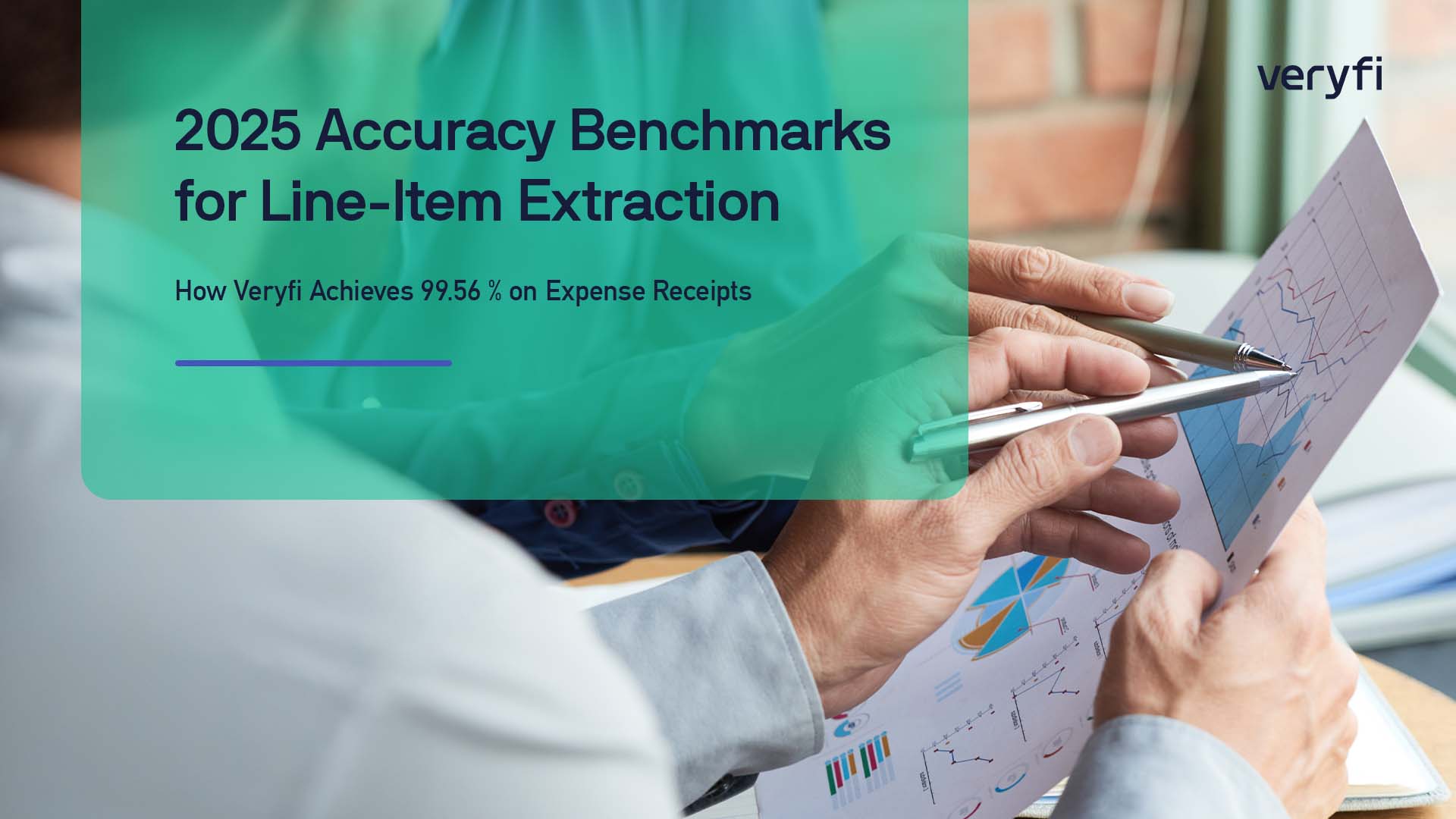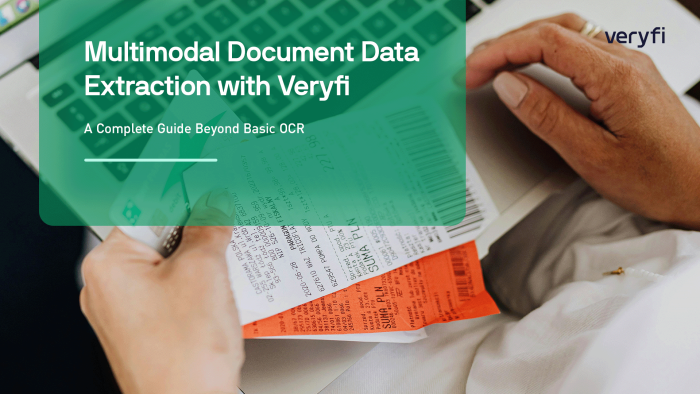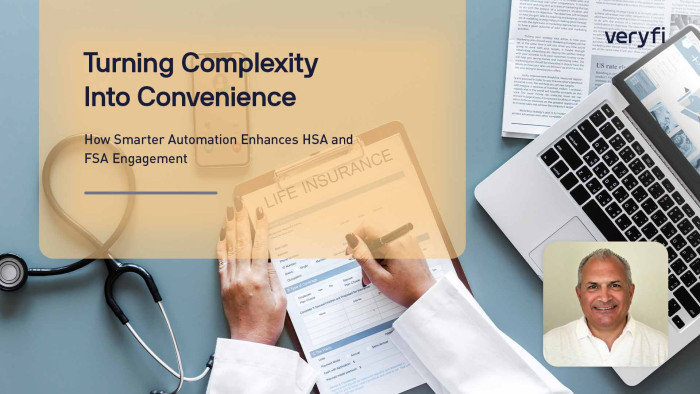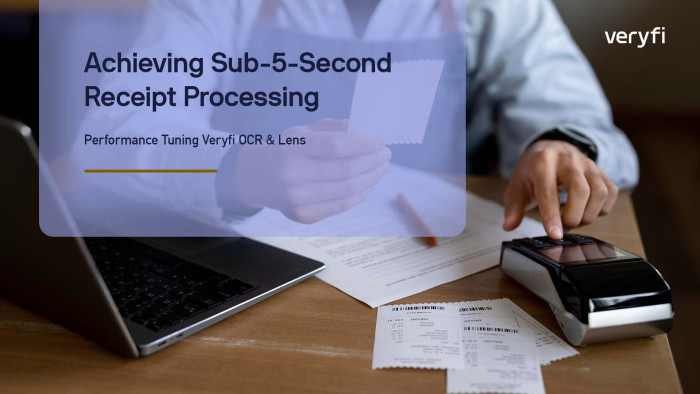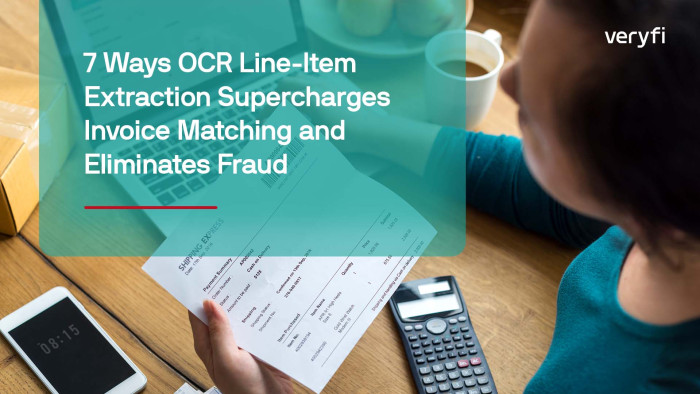Introduction
As we advance into 2026, the landscape of financial document processing is undergoing a seismic shift. With 74% of CFOs planning to implement line-item AI by the end of 2025, the demand for accurate, reliable document extraction has never been higher. The stakes are particularly high for expense receipt processing, where even minor inaccuracies can cascade into significant compliance issues and financial discrepancies.
Recent benchmark studies reveal a stark reality: while many AI models struggle with complex document structures, deterministic approaches are emerging as the clear winners for enterprise-grade accuracy. (Benchmark: How Well AI Models Handle Table Processing) This comprehensive analysis examines why Veryfi’s deterministic models consistently outperform GPT-4o combinations on receipt processing, achieving an impressive 99.56% accuracy rate that translates to processing 9,999 receipts correctly out of every 10,000. (Veryfi Receipt Processing)
For QA engineers and technical decision-makers, understanding these benchmarks isn’t just about numbers—it’s about building repeatable test harnesses that ensure consistent performance in production environments. This article dissects the technical foundations behind these accuracy achievements and provides actionable insights for implementing robust document processing systems.
The Current State of AI Document Processing in 2025
Industry Adoption Trends
Financial institutions are processing an average of 800 million pages of documents annually, with manual processing carrying an average error rate of 3.6% in data entry tasks. This massive volume, combined with the inherent error rates of manual processing, has created an urgent need for automated solutions that can deliver consistent, auditable results.
The shift toward AI-driven document processing represents more than just efficiency gains—it’s a fundamental transformation in how organizations handle financial data. Traditional OCR systems, which rely on pattern recognition and pre-defined algorithms, are being rapidly replaced by more sophisticated AI-driven approaches that can handle complex document layouts and varying formats.
The Challenge of Receipt Processing
Receipts present unique challenges in document processing due to their varied formats, inconsistent layouts, and the critical importance of line-item accuracy. (Veryfi Receipt Processing) Unlike standardized invoices or forms, receipts can vary dramatically in structure, font sizes, and information density, making them particularly challenging for traditional OCR systems.
Veryfi’s AI-driven technology addresses these challenges by providing 97% accuracy compared to manual receipt processing, with specialized capabilities for extracting complex data fields including merchant name, purchase amount, invoice date, billing zip code, sales tax amount, and detailed line-item information. (Veryfi Receipt Processing) This level of accuracy is particularly crucial for expense management systems where financial compliance depends on precise data extraction.
Benchmark Methodology and Testing Framework
Establishing Repeatable Test Harnesses
Creating effective benchmarks for document processing requires a systematic approach that accounts for real-world variability while maintaining scientific rigor. Recent comparative studies have established frameworks for testing AI models across different document types and complexity levels.
For QA engineers developing test harnesses, the key is establishing datasets that represent the full spectrum of document variations encountered in production environments. This includes documents from different time periods, varying quality levels, and diverse formatting styles. The most effective testing frameworks incorporate both synthetic test cases and real-world document samples to ensure comprehensive coverage.
Comparative Analysis Framework
Recent benchmark studies have evaluated seven popular AI models for document processing, including Amazon Analyze Expense API, Azure AI Document Intelligence, Google Document AI, GPT-4o API variants, Gemini 2.0 Pro, and specialized solutions. These comparisons reveal significant performance variations across different document types and processing scenarios.
The testing methodology typically involves processing standardized document sets through each system and measuring accuracy across multiple dimensions: field extraction accuracy, processing speed, consistency across similar documents, and handling of edge cases. For receipt processing specifically, this includes evaluating performance on itemized charges, tax calculations, merchant information, and complex line-item structures.
Deterministic vs. Nondeterministic Approaches
The Deterministic Advantage
The fundamental difference between deterministic and nondeterministic algorithms in OCR lies in their predictability and consistency. Deterministic algorithms produce the same output for a given set of input parameters, ensuring consistent results across multiple processing runs. (Deterministic Algorithms vs Nondeterministic Algorithms in OCR) This consistency is crucial for enterprise applications where auditing, compliance, and record-keeping require reproducible results.
Veryfi’s approach leverages deterministic algorithms combined with in-house training to create OCR models that deliver superior performance compared to nondeterministic counterparts. (Deterministic Algorithms vs Nondeterministic Algorithms in OCR) This deterministic nature provides several key advantages: predictable performance metrics, consistent accuracy across similar documents, and the ability to create reliable test harnesses for quality assurance.
Why GPT-4o Combinations Fall Short
While large language models like GPT-4o demonstrate impressive capabilities in many domains, their nondeterministic nature creates challenges for document processing applications requiring consistent accuracy. The variability inherent in these models means that identical documents may produce different extraction results across multiple processing attempts, making them unsuitable for applications requiring audit trails and compliance documentation.
Furthermore, general-purpose language models lack the specialized training on document structures and financial data formats that purpose-built OCR systems possess. (Regular OCR versus AI-Driven OCR? Which Is Right for Your Business?) This specialization gap becomes particularly apparent when processing complex receipt formats with multiple line items, varying tax structures, and diverse merchant layouts.
Veryfi’s 99.56% Accuracy Achievement
Technical Architecture and Approach
Veryfi’s achievement of 99.56% accuracy on expense receipts stems from a combination of specialized AI training, deterministic processing algorithms, and comprehensive data extraction capabilities. The platform processes receipts in 3-5 seconds while maintaining this high accuracy rate, demonstrating that speed and precision are not mutually exclusive in modern document processing systems.
The system’s architecture incorporates pre-trained, AI-driven OCR technology that requires no human intervention, ensuring Day 1 Accuracy™ for enterprise implementations. This approach eliminates the variability and potential errors introduced by human-in-the-loop systems while maintaining the flexibility to handle diverse document formats.
Comprehensive Data Extraction Capabilities
Veryfi’s receipt processing capabilities extend far beyond basic merchant and amount extraction. The system captures detailed line-item information including product descriptions, quantities, unit prices, extended prices, tax indicators, and merchant-specific data such as postal codes and tax IDs. (Veryfi Receipt Processing) This comprehensive extraction capability is essential for modern expense management systems that require detailed transaction analysis and compliance reporting.
The platform’s ability to handle 91 currencies and 38 languages further demonstrates its enterprise-ready capabilities, making it suitable for global organizations with diverse document processing requirements. (Veryfi Receipt Processing) This multilingual and multicurrency support is particularly important as businesses expand internationally and require consistent processing accuracy across different regions and document formats.
Real-World Performance Metrics
The 99.56% accuracy rate translates to practical business outcomes that extend beyond simple error reduction. One customer has reported successful processing of 9,999 receipts out of each 10,000 processed, demonstrating the system’s reliability in high-volume production environments. (Veryfi Receipt Processing) This level of performance enables organizations to implement fully automated expense processing workflows with minimal manual intervention.
For healthcare and medical receipts, Veryfi’s specialized processing capabilities can accelerate HCSA and FSA receipt data extraction, addressing the unique requirements of healthcare-related expense processing. (Veryfi HSA/HCSA/FSA Receipt Processing) This specialization demonstrates the platform’s ability to adapt its core technology to specific industry requirements while maintaining high accuracy standards.
Confidence Scoring and Quality Assurance
Implementing Confidence Metrics
Effective document processing systems must provide more than just extracted data—they need to communicate the reliability of that extraction through confidence scoring mechanisms. These scores enable downstream systems to make informed decisions about when to route documents for manual review versus automatic processing. For QA engineers, confidence scores provide crucial metrics for establishing processing thresholds and quality gates.
Veryfi’s approach to confidence scoring incorporates multiple factors including character recognition certainty, field validation results, and consistency checks across related data points. This multi-dimensional approach to confidence assessment provides more nuanced quality indicators than simple binary pass/fail metrics, enabling more sophisticated automated decision-making in production systems.
Building Robust Test Harnesses
QA engineers implementing document processing systems need repeatable test harnesses that can validate performance across diverse document types and processing scenarios. The most effective test harnesses incorporate several key components: standardized document sets representing real-world variability, automated accuracy measurement tools, performance benchmarking capabilities, and regression testing frameworks.
For receipt processing specifically, test harnesses should include documents with varying complexity levels: simple single-item receipts, complex multi-item transactions, receipts with promotional discounts, international receipts with different tax structures, and edge cases such as partially damaged or low-quality scanned documents. This comprehensive testing approach ensures that accuracy metrics reflect real-world performance rather than idealized laboratory conditions.
Industry-Specific Applications and Use Cases
Healthcare and Medical Receipts
Healthcare organizations face unique challenges in receipt processing due to regulatory requirements and the need for precise documentation of medical expenses. Veryfi’s specialized capabilities for health and medical receipts can significantly accelerate HCSA and FSA receipt data extraction while maintaining compliance with healthcare regulations. (Veryfi HSA/HCSA/FSA Receipt Processing) The system’s ability to extract detailed medical service information, provider details, and insurance-related data makes it particularly valuable for healthcare expense management applications.
The platform’s GDPR, HIPAA, and CCPA compliance ensures that sensitive healthcare data remains protected throughout the processing pipeline. (Veryfi HSA/HCSA/FSA Receipt Processing) This compliance framework is essential for healthcare organizations that must maintain strict data protection standards while achieving processing efficiency gains.
Consumer Packaged Goods and Retail
For CPG and FMCG companies, receipt processing serves multiple purposes beyond expense management, including loyalty program administration, market research, and consumer behavior analysis. Veryfi’s product intelligence capabilities enable detailed extraction of product information, SKU data, and purchase patterns from retail receipts. (Veryfi Product Intelligence) This detailed product-level extraction supports sophisticated analytics and customer engagement programs.
The system’s ability to process CPG and FMCG receipts with high accuracy enables companies to build comprehensive customer purchase profiles and implement targeted marketing campaigns based on actual purchase behavior. (Veryfi CPG/FMCG Receipt Processing) This capability is particularly valuable for companies implementing loyalty programs or conducting market research based on actual consumer purchase data.
Security and Compliance Considerations
Addressing AI-Generated Document Fraud
As AI technology advances, the threat of AI-generated document fraud has become increasingly sophisticated. ChatGPT’s image generation capabilities can now create hyper-realistic fake receipts that include itemized charges, tax calculations, and business logos, posing significant challenges for traditional validation systems. (Detecting the Fakes: How Veryfi Is Combating AI-Generated Receipts)
Veryfi’s AI Fake Document Detective addresses this emerging threat by analyzing document characteristics that are difficult for generative AI to replicate accurately. (Detecting the Fakes: How Veryfi Is Combating AI-Generated Receipts) This fraud detection capability is becoming increasingly important as organizations face more sophisticated attempts to submit fraudulent expense documentation.
Enterprise Security Framework
Modern document processing systems must balance accessibility with security, particularly when handling sensitive financial information. Veryfi’s platform operates with SOC 2 Type II security certification and implements top-level encryption to ensure sensitive data protection throughout the processing pipeline. (Veryfi Receipt Processing) This security framework enables organizations to implement automated processing while maintaining compliance with financial data protection requirements.
The platform’s “no humans in the loop” approach further enhances security by eliminating potential human access points to sensitive financial data. (Veryfi Receipt Processing) This automated approach reduces security risks while ensuring consistent processing quality and maintaining audit trails for compliance purposes.
Implementation Best Practices for QA Engineers
Establishing Performance Baselines
Successful implementation of document processing systems requires establishing clear performance baselines that account for both accuracy and processing speed. QA engineers should develop comprehensive test suites that measure accuracy across different document types, processing speeds under various load conditions, and system reliability over extended periods.
For receipt processing specifically, baseline measurements should include accuracy rates for different field types (merchant names, amounts, dates, line items), processing times for documents of varying complexity, and system performance under peak load conditions. These baselines provide the foundation for ongoing performance monitoring and system optimization.
Continuous Monitoring and Optimization
Document processing systems require ongoing monitoring to maintain performance standards as document formats evolve and processing volumes change. Effective monitoring systems track accuracy trends over time, identify emerging document format challenges, and provide early warning of performance degradation.
QA engineers should implement automated monitoring systems that continuously validate processing accuracy against known-good datasets, track processing performance metrics, and alert teams to potential issues before they impact production systems. This proactive approach to quality assurance ensures that high accuracy standards are maintained as systems scale and evolve.
Comparative Analysis: Veryfi vs. Alternatives
Performance Benchmarking Results
Recent comparative analyses of OCR APIs for invoice and receipt processing reveal significant performance differences across platforms. (Best OCR API for Invoice Processing & AP Automation) While many solutions claim high accuracy rates, real-world testing often reveals substantial gaps between marketing claims and actual performance.
Veryfi’s deterministic approach consistently outperforms alternatives in scenarios requiring high accuracy and consistent results. The platform’s specialized training on financial documents and receipt formats provides advantages that general-purpose OCR systems cannot match. (Best OCR API for Invoice Processing & AP Automation)
Cost-Benefit Analysis
While accuracy is crucial, organizations must also consider the total cost of ownership when selecting document processing solutions. This includes not only licensing costs but also implementation time, ongoing maintenance requirements, and the cost of handling processing errors. Veryfi’s high accuracy rates reduce the downstream costs associated with error correction and manual review processes.
The platform’s day-1 accuracy and pre-trained models reduce implementation time and eliminate the need for extensive training data preparation. This rapid deployment capability provides significant value for organizations needing to implement document processing solutions quickly while maintaining high quality standards.
Future Trends and Considerations
Evolution of Document Processing Standards
As AI-driven document processing becomes more prevalent, industry standards for accuracy measurement and performance benchmarking are evolving. Organizations are moving beyond simple accuracy percentages to more nuanced metrics that account for different types of errors, processing confidence levels, and real-world performance variability.
The trend toward deterministic processing approaches reflects the enterprise need for predictable, auditable results. (Deterministic Algorithms vs Nondeterministic Algorithms in OCR) This shift suggests that while general-purpose AI models may excel in creative applications, specialized deterministic systems will continue to dominate enterprise document processing applications.
Integration with Broader AI Ecosystems
Modern document processing systems must integrate seamlessly with broader AI and automation ecosystems. This includes compatibility with workflow automation platforms, business intelligence systems, and compliance monitoring tools. Veryfi’s API-first architecture and comprehensive data extraction capabilities position it well for these integration requirements.
The platform’s support for 91 currencies and 38 languages demonstrates the global scalability required for modern enterprise applications. (Veryfi Receipt Processing) As organizations continue to expand internationally, this multilingual capability becomes increasingly important for maintaining consistent processing quality across diverse markets.
Conclusion
The 2025 landscape of document processing is defined by the tension between accuracy requirements and processing efficiency. Veryfi’s achievement of 99.56% accuracy on expense receipts demonstrates that deterministic approaches can deliver the consistent, reliable performance that enterprise applications require. (Veryfi Receipt Processing)
For QA engineers and technical decision-makers, the key insights from this analysis are clear: deterministic processing approaches provide superior consistency for enterprise applications, comprehensive test harnesses are essential for validating real-world performance, and specialized training on financial documents delivers better results than general-purpose AI models. (Deterministic Algorithms vs Nondeterministic Algorithms in OCR)
As 74% of CFOs plan to implement line-item AI by 2025, the organizations that succeed will be those that prioritize accuracy and consistency over flashy but unreliable alternatives. Veryfi’s proven track record of processing 9,999 out of 10,000 receipts correctly provides the foundation for building robust, scalable document processing systems that meet enterprise requirements for accuracy, security, and compliance. (Veryfi Receipt Processing)
The future of document processing lies not in pursuing the latest AI trends, but in implementing proven, deterministic approaches that deliver consistent results at scale. For organizations serious about automating their financial document processing, the benchmark has been set at 99.56% accuracy—and the technology to achieve it is available today.
FAQ
How does Veryfi achieve 99.56% accuracy on expense receipt processing?
Veryfi achieves 99.56% accuracy through deterministic AI models that produce consistent, reproducible results for the same input parameters. Unlike nondeterministic approaches, Veryfi’s pre-trained AI-driven OCR technology ensures Day 1 Accuracy™ with no human intervention required. The deterministic nature makes it superior for auditing, compliance, and record-keeping purposes while maintaining enterprise-grade reliability.
What makes deterministic AI models better than GPT-4o for document processing?
Deterministic AI models provide consistent, reproducible results for identical inputs, making them ideal for enterprise applications requiring audit trails and compliance. While GPT-4o and other nondeterministic models may produce varying outputs for the same document, deterministic algorithms ensure the same structured data extraction every time. This consistency is crucial for financial document processing where accuracy and reliability are paramount.
What types of receipts can Veryfi process with high accuracy?
Veryfi can process various types of receipts including standard expense receipts, HSA/HCSA/FSA receipts, and complex financial documents. The platform’s AI-driven OCR technology is designed to handle different receipt formats, layouts, and quality levels while maintaining high accuracy rates. Veryfi’s technology instantly turns unstructured receipt documents into structured data for use in expense management and enterprise applications.
How do confidence scoring mechanisms work in enterprise document processing?
Confidence scoring mechanisms provide QA engineers with quantitative measures of extraction reliability for each data field. These scores help identify potentially problematic extractions before they enter downstream systems, enabling automated quality control workflows. Enterprise systems use these confidence thresholds to route documents for human review when scores fall below acceptable levels, ensuring data integrity across large-scale processing operations.
Why is 99.56% accuracy significant for expense management systems?
With 74% of CFOs planning to implement line-item AI by 2025, achieving 99.56% accuracy represents a breakthrough in touchless processing capabilities. This accuracy level enables automated validation, faster approvals, and significantly reduces manual intervention in accounts payable workflows. For enterprise expense management, this means reduced processing costs, minimized fraud risk, and accelerated financial operations while maintaining audit-ready documentation.
What benchmarking frameworks should QA engineers use for document processing systems?
QA engineers should implement comprehensive benchmarking frameworks that test accuracy across diverse document types, layouts, and quality conditions. Key metrics include field-level extraction accuracy, confidence score reliability, processing speed, and error rate analysis. Benchmarks should include real-world document variations, edge cases, and comparative analysis against industry standards to ensure robust performance in production environments.
